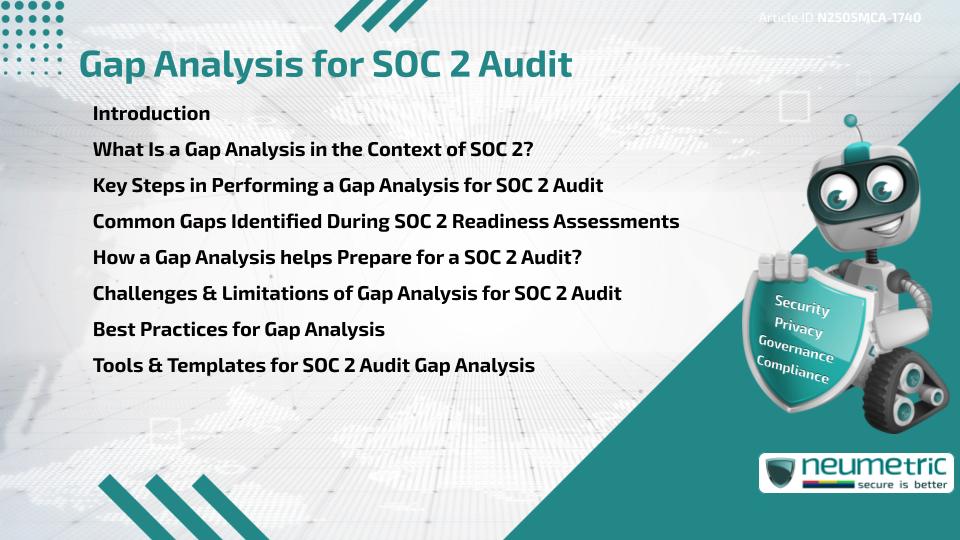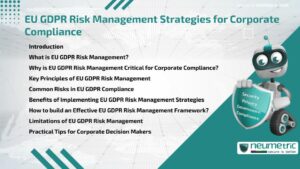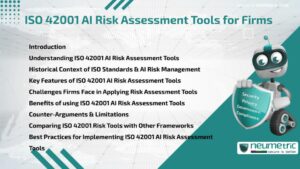Table of Contents
ToggleIntroduction
In the world of Data Security & Compliance, being prepared for a SOC 2 Audit means understanding your current state versus what the Standard expects. This is where a Gap Analysis for SOC 2 Audit becomes essential. It offers a structured way to assess your existing Controls, identify shortcomings & set a clear path to achieve Compliance. For Startups, SaaS Companies & Enterprises, a Well-executed Gap Analysis is often the difference between a smooth audit & a delayed Report.
What Is a Gap Analysis in the Context of SOC 2?
A Gap Analysis for SOC 2 Audit is a Process that compares your Organisation’s Security Controls & Practices against the Trust Services Criteria (TSC). These include Security, Availability, Processing Integrity, Confidentiality & Privacy. The goal is to uncover What you are doing well, What is missing & What needs to be improved or documented better.
This Analysis is not the Audit itself. Instead, it is a Readiness exercise that helps you prepare for the official Audit by a licensed CPA firm.
Key Steps in Performing a Gap Analysis for SOC 2 Audit
Conducting a Gap Analysis for SOC 2 Audit typically involves:
- Understanding Scope – Identify Systems, Services or Departments to be Audited.
- Reviewing current Controls – Document your current Policies, Procedures & Technical Safeguards.
- Mapping Controls – Align your Controls with the SOC 2 criteria to find Gaps.
- Identifying Remediation Tasks – Highlight Gaps that require attention, such as missing Policies or Unmonitored Systems.
- Prioritising Fixes – Assign Priority Levels to each Gap based on Risk & Audit relevance.
- Developing a Remediation Plan – Outline Steps & Timelines to address all Critical issues.
Common Gaps Identified During SOC 2 Readiness Assessments
During a Gap Analysis for SOC 2 Audit, Companies often find the following issues:
- Lack of formalised Security Policies or Procedures
- Inadequate Access Controls or Change Management Practices
- Missing Risk Assessments
- Incomplete Audit Logs or Monitoring
- Weak Onboarding or Offboarding Processes
These are all fixable, but early detection helps avoid Audit delays or failures.
How a Gap Analysis helps Prepare for a SOC 2 Audit?
The true value of a Gap Analysis for SOC 2 Audit lies in its ability to show your Audit Readiness. It offers a structured Roadmap, highlights Control weaknesses & gives Teams time to implement Corrective Actions before the actual Audit begins.
Without a Gap Analysis, organisations often waste time fixing issues reactively during the Audit Process. A Pre-audit Analysis saves time, Money & Stress by allowing proactive Remediation.
Challenges & Limitations of Gap Analysis for SOC 2 Audit
While useful, a Gap Analysis for SOC 2 Audit is not a guarantee of success. It has limitations:
- It depends on the Quality of Documentation & Internal Knowledge.
- It can miss Contextual or Technical Gaps if not conducted by experienced Professionals.
- If done too early or too late in your Readiness Process, it may be ineffective.
It is also worth noting that SOC 2 Criteria are Principle-based & Flexible. This means multiple approaches can meet the same requirement & a Gap Analysis needs Expert interpretation.
Best Practices for Gap Analysis
To make the most out of your Gap Analysis for SOC 2 Audit, consider these Practices:
- Involve Stakeholders from IT, Legal, Operations & Leadership.
- Use Standardised Checklists aligned to the AICPA guidelines.
- Focus on both Technical & Administrative Controls.
- Document everything for Audit transparency.
- Repeat the Analysis before the Audit to validate Readiness.
Tools & Templates for SOC 2 Audit Gap Analysis
Several Tools & Templates can simplify your Gap Analysis for SOC 2 Audit:
- Cloud Security Alliance’s CAIQ for Cloud Services
- Internal Audit Checklists
- Spreadsheets with mapped TSC Controls
- Workflow Tools like Notion, Confluence or Trello
- Compliance Automation Platforms (used selectively & validated manually)
The key is to keep the Process structured & repeatable.
Takeaways
- A Gap Analysis for SOC 2 Audit helps Organisations assess Readiness & Uncover Gaps early.
- It is a critical Pre-audit step that saves Time & Effort.
- Addressing identified Gaps builds Audit confidence & improves Security Posture.
- Limitations exist but can be overcome through expert input & structured planning.
- Leveraging Tools & Internal collaboration boosts efficiency.
FAQ
What is the Purpose of a Gap Analysis for SOC 2 Audit?
It helps Organisations understand their current Control Environment & Identify what needs improvement before a Formal SOC 2 Audit.
Is Gap Analysis mandatory for SOC 2 Audit?
No, it is not mandatory but strongly recommended as it increases the chances of passing the Audit without surprises.
How long does a Gap Analysis for SOC 2 Audit take?
Depending on the Organisation’s size, it can take anywhere from one (1) week to four (4) weeks.
Who should Perform the Gap Analysis for SOC 2 Audit?
Ideally, an Internal Compliance Lead or an External Consultant with SOC 2 experience should perform the Gap Analysis.
Can small Startups conduct a Gap Analysis for SOC 2 Audit Internally?
Yes, with the right Guidance & Templates, small Startups can begin the Process internally & seek validation later.
What are the Risks of skipping a Gap Analysis for SOC 2 Audit?
Skipping it may lead to missed Compliance Gaps, Audit delays or failed Assessments.
Does Gap Analysis cover all SOC 2 Principles?
Yes, if Scoped properly, it can cover all Five (5) Trust Services Criteria.
How often should a Gap Analysis for SOC 2 Audit be conducted?
At least once before each Annual Audit or After any major changes in systems or Processes.
Are there free Resources to start a Gap Analysis for SOC 2 Audit?
Yes, Organisations can use Non-commercial Templates & Guides from the Cloud Security Alliance or the AICPA.
References
- https://www.aicpa.org/resources/toolkit/trust-services-criteria
- https://cloudSecurityalliance.org/artifacts/cloud-Controls-matrix-ccm/
- https://www.isaca.org/resources/news-and-trends/newsletters/atisaca/2020/volume-18/what-is-soc-2
- https://www.aicpa.org/resources/article/guide-to-soc-2-reports
- https://cloudSecurityalliance.org
Need help?
Neumetric provides organisations the necessary help to achieve their CyberSecurity, Compliance, Governance, Privacy, Certifications & Pentesting goals.
Organisations & Businesses, specifically those which provide SaaS & AI Solutions, usually need a CyberSecurity Partner for meeting & maintaining the ongoing Security & Privacy needs & requirements of their Clients & Customers.
SOC 2, ISO 27001, ISO 42001, NIST, HIPAA, HECVAT, EU GDPR are some of the Frameworks that are served by Fusion – a centralised, automated, AI-enabled SaaS Solution created & managed by Neumetric.
Reach out to us!





